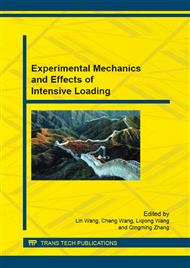p.119
p.124
p.130
p.137
p.143
p.153
p.158
p.164
p.170
Study on the Evolution of Adiabatic Shear Band of a High Strength Steel
Abstract:
The evolution process of a high strength steel which subjected with three different heat treatment proceedings and gets different quasi-static tensile properties was investigated in this paper. To precisely control the plastic deformation of the cylinder and capture the development process of adiabatic shear bands, stopper ring was used in Split Hopkinson Pressure Bar (SHPB). Combining the stress-strain curves and microstructures after SHPB tests, the microstructure evolution from the nucleation of adiabatic shear bands to fracture of the cylindrical steel were observed. The experimental results have demonstrated that there are similar fracture procedures of the steel treated through different heat treatments. Shear bands form firstly, then micro-cracks develop from shear bands, and lead to macro-crack finally. However, the critical strains for nucleation of ASBs and the time spending on the fracture procedure of the steel treated at different heat treatments are different. Samples treated at 900°C/AC exhibit the best resistance to adiabatic shear sensitivity when compressed under high strain rates.
Info:
Periodical:
Pages:
143-150
Citation:
Online since:
August 2015
Authors:
Price:
Сopyright:
© 2015 Trans Tech Publications Ltd. All Rights Reserved
Share:
Citation:


